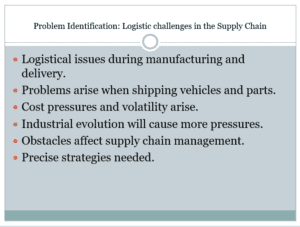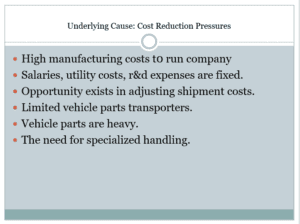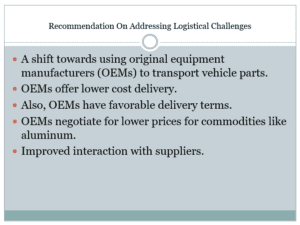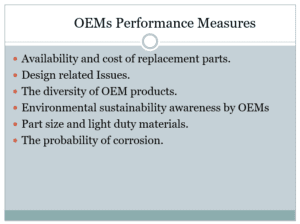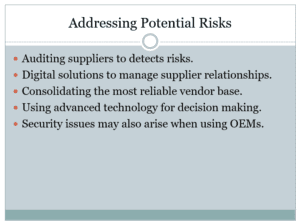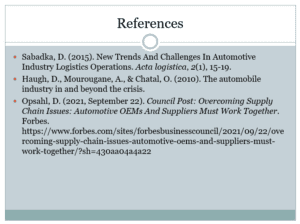Fixing Operational Issues at Honda
Hello, and welcome to today’s presentation. The presentation identifies a critical operational issue facing Honda, a leading global automobile manufacturer. As one of the industry leaders in the automobile manufacturing industry, Honda must fulfill consumers’ demands by delivering orders and ensuring quality. However, the company faces serious logistics issues along the supply chain, hindering the company from satisfying consumer needs. We will delve into the operational issue in detail and recommendations on how Honda can solve the issue.
The process of manufacturing vehicles and other automobile products is no easy process. Automobile companies face challenges during the shipment of materials used in the manufacturing process and when delivering cars to customers. Logistical challenges during shipment result in demand and supply volatility (Sabadka, 2015). Besides, logistical challenges may result in cost pressures on the company’s part. These problems facing Honda and other automobile companies can only increase as the industry experiences significant evolution.
Honda managers face the reality of high costs witnessed in the automobile industry. The overall costs of manufacturing vehicles are so high that managers have to try and control them to increase profit margins for their companies. However, Honda cannot regulate salaries, utility costs, research and development expenses, and other essential expenditures. The only option left for managers is to wiggle shipment costs to bolster profit margins. However, that is not always possible since there are only a few transporters of the heavy vehicle parts, making the negotiation process even harder. Besides, some motor vehicle parts require specialized handling that can only be provided by specialized transporters who charge highly (Sabadka, 2015).
Another issue that causes logistics problems along Honda’s supply chain is the volatility and unpredictability of the automobile market. Unpredictability is beyond the company’s control; thus, Honda has to contend with the issue. One of the issues that may affect demand and the logistics network is the recall of vehicles due to quality issues. Whenever that happens, the automobile maker has to move the cars already in transit back to the company resulting in substantial financial losses. Also, a change and regulatory measures in particular markets impact the demand for vehicles, sometimes making the company move parts from one transit point to another. For instance, Brexit affected vehicle material imports from the UK and the larger EU block (Haugh, Mourougane & Chatal, 2010).
To alleviate the logistical challenges encountered during the shipment of vehicle parts, the automobile company should use original equipment manufacturers to transport the products. Original equipment manufacturers have so much market power that they can negotiate for lower transport costs and better delivery terms from logistics companies (Opsahl, 2021). Apart from helping automobile companies attain lower delivery costs, OEMs may also negotiate for lower costs for lower prices for other vehicle products (Opsahl, 2021). Besides quality issues are less likely to arise since the supplying company will scrutinize its products more closely. Essentially, an increased partnership between Honda and its OEMs eliminates most supply chain challenges.
According to Hammond, Amezquita & Bras (1998), one of the positive outcomes resulting from contracting original equipment manufacturers is the increased customization of their products. Vehicle users can visit OEM stations and order for customized parts for their vehicles. Unlike the original parts, OEM products are sometimes made with so much precision that they tend to be of better quality than the initial parts. Besides, OEMs offer their products at relatively lower prices compared to other industry players, thereby attracting more customers. Unlike aftermarket products, OEM parts operate at the same efficacy level as the initial vehicle parts. Engaging OEMs alleviates quality issues from the supply chain.
A Primary performance measure of OEM products is the availability and cost of replacement parts. OEM companies must overcome challenges that make it difficult to remanufacture parts if they are to be relied upon by an automobile company. Also, design matters when it comes to addressing the remanufacturing process. A question asked with regard to this is whether the company can remanufacture the product once disassembly occurs. Also, additional specialized tooling must be availed for a remanufactured product to be effective. , The product diversity of OEM products also matters. The OEM must manufacture different versions of the same part for one car model. Parts proliferation eliminates the likelihood of some products not fitting into some vehicles. Other performance measures include climate friendliness and probability of corrosion, among others (Hammond, Amezquita & Bras, 1998).
To address the risks that accompany the usage of OECD products, the company should require the vehicle parts suppliers to have their risk assessment and contingency plans. That should be the minimum requirement an automobile company like Honda should implement before engaging OEMs. That means these companies will hold themselves accountable and commit to ensuring high product standards. Another way to address OEM risks is consolidating a reliable vendor supplier base that is unlikely to disappoint the company. Also, digital solutions come in handy because they help the company address supplier-related problems. For instance, a supplier management program will help the automobile company bolster relationships and trust with customers and stakeholders (DiMase et al., 2016).
Sabadka, D. (2015). New Trends And Challenges In Automotive Industry Logistics Operations. Acta logistica, 2(1), 15-19.
Haugh, D., Mourougane, A., & Chatal, O. (2010). The automobile industry in and beyond the crisis.
Opsahl, D. (2021, September 22). Council Post: Overcoming Supply Chain Issues: Automotive OEMs And Suppliers Must Work Together. Forbes. https://www.forbes.com/sites/forbesbusinesscouncil/2021/09/22/overcoming-supply-chain-issues-automotive-oems-and-suppliers-must-work-together/?sh=430aa04a4a22
Hammond, R., Amezquita, T., & Bras, B. (1998). Issues in the automotive parts remanufacturing industry: a discussion of results from surveys performed among remanufacturers. Engineering Design and Automation, 4, 27-46.
DiMase, D., Collier, Z. A., Carlson, J., Gray Jr, R. B., & Linkov, I. (2016). Traceability and risk analysis strategies for addressing counterfeit electronics in supply chains for complex systems. Risk Analysis, 36(10), 1834-1843.
ORDER A PLAGIARISM-FREE PAPER HERE
We’ll write everything from scratch
Question

Fixing Operational Issues at Honda
Based on your analysis of the operational problem and identification of the reasons for system/process failure, it’s time to develop your presentation to your client organization’s executive team.
The content of your presentation should
- identify the operational problem
- convey your analysis of the issue, the system or process failure, and the identified or potential root causes
- clearly state and support your recommendations for improvement with appropriate charts, workflow diagrams, etc.
- create a timeline and identify the actions to be taken to ensure successful implementation
- forecast the outcomes you expect to see as a result of your recommendations and how they will contribute to the organization’s value chain
- identify the performance measures the organization should put in place to determine if the improvements are working.
- consider any measures that may need to be put in place to minimize potential risks, particularly In relation to new information technology and data security/ integrity.
- Your final References list in APA format
Aesthetic and delivery considerations
- 12 – 15 minutes in length
- Use a consistent theme with uncluttered slides (the golden rule is no more than six bullets, six words per bullet in 32-point font or above)
- Remember less is more and the best presenters can expand on the slides not read from them
- Include a title slide
- Use speaker notes to expand on the bullets
- Slides and commentary transition seamlessly
- Visuals can often convey information more effectively than words, so create and import charts, diagrams, etc appropriately.
- Introduce yourself before you begin
- Thank the audience for their attention
- Invite questions at the end of the presentation


